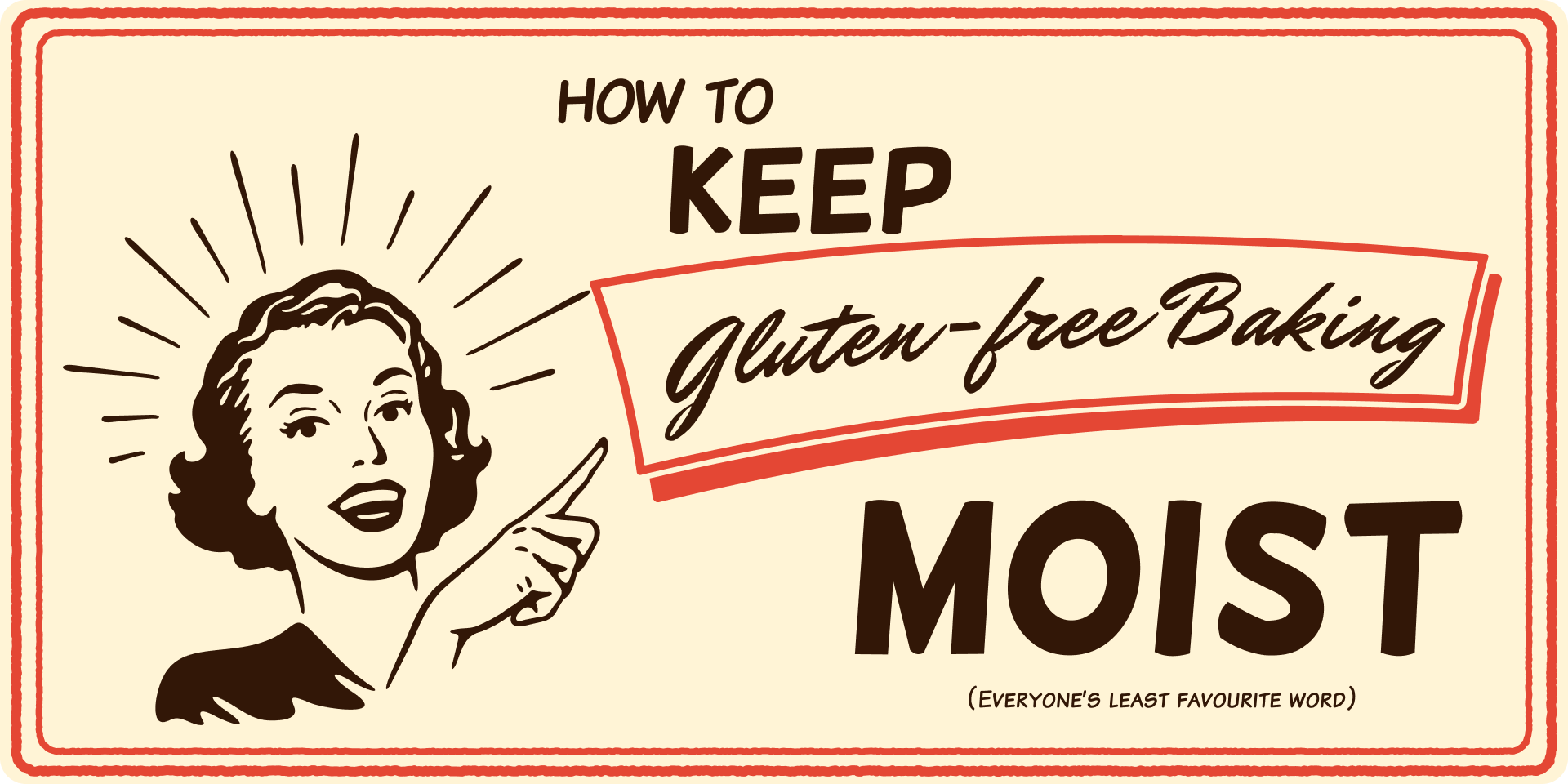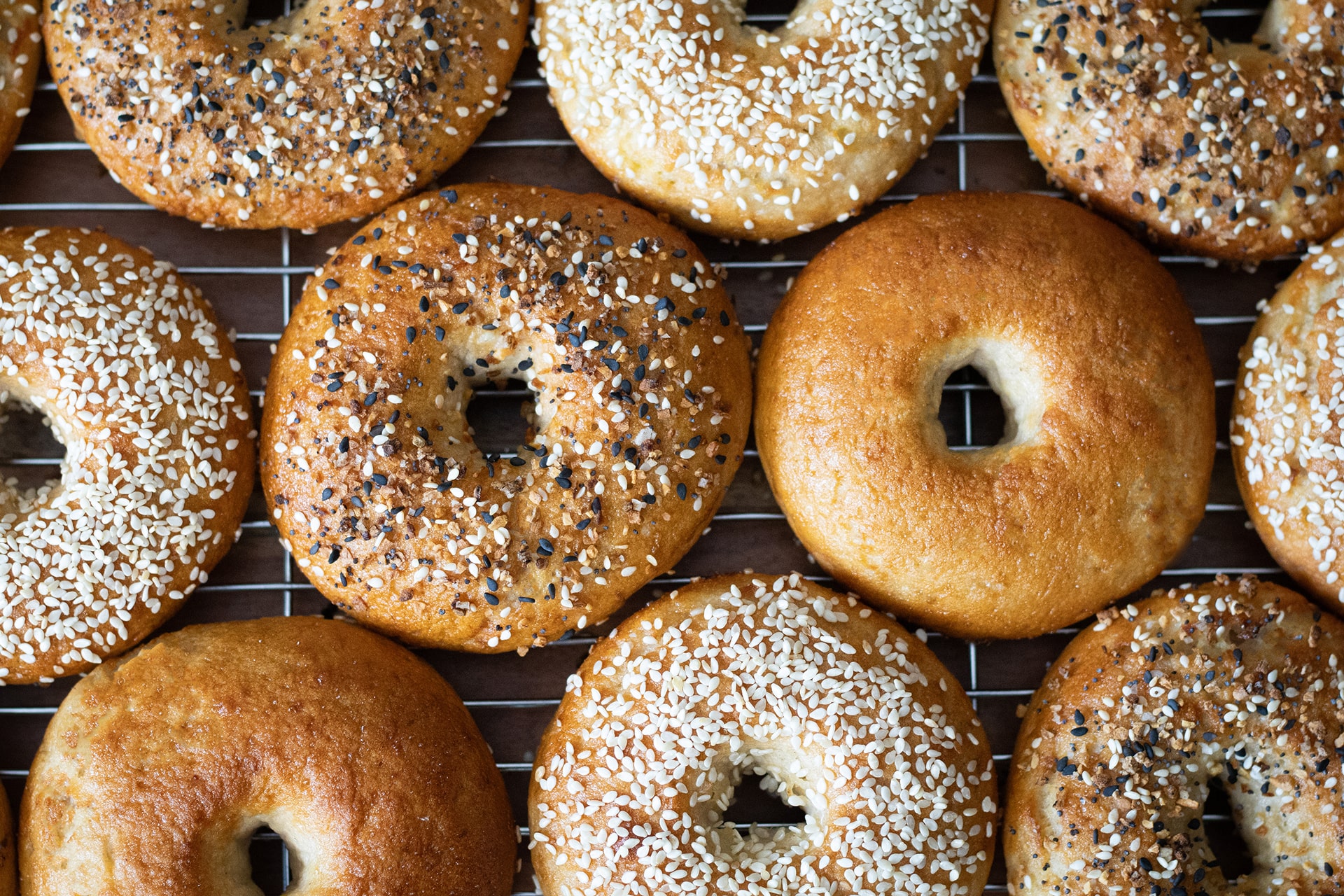What is the trick to gluten-free baking?
Why gluten-free baking is different—and how to make it work every time.

Let’s be honest—gluten-free baking can feel like some kind of culinary prank.
You follow the recipe exactly, you precisely measure your ingredients, following the method to a T, and then:
Crumbly.
Dry.
Flat.
Weirdly gummy.
(Or all four. I’ve been there.)
If you’ve ever stared into the depths of a sunken loaf and muttered “What is the trick to gluten-free baking?”, you’re not alone.
The good news? There is a trick. Or rather, a handful of them. And once you understand what gluten actually does—and how to replace it—you’ll be baking up fluffy breads, chewy cookies, and cakes (that don’t taste like punishment) in no time.
Why is Gluten-free Baking so Hard?
First: why is gluten-free baking so darn hard?
I like to say that gluten-free baking isn’t necessarily hard, it’s just different. Once you understand gluten’s role in traditional baking and learn more about the different types of gluten-free ingredients, gluten-free baking makes a lot more sense.
Gluten is the protein found in wheat, barley, and rye. It’s what that gives dough its stretchiness, structure, and that lovely, chewy texture we associate with fresh bread or perfect cookies.
When flour is mixed with water and worked (like kneading dough), gluten strands form a stretchy, elastic web. That structure traps gas from leavening agents, giving baked goods their rise, chew, and stability. It's the backbone of traditional baking.
So, when you remove gluten, you're removing the thing that holds the whole operation together. No stretch, no bounce, no chewy crumb.
That’s why gluten-free baking can feel like everything’s falling apart… because, well, it kind of is.
The challenge isn’t just taking gluten out—it’s replacing the functions it provides. That’s where things like starches, grain flours, and binders come in. But each one behaves differently, and it takes some understanding (and experimenting) to get them to work together.
Gluten-free baking isn’t impossible, it just requires a shift in approach. Once you understand what’s missing, you can start rebuilding structure with the right tools. And that’s when things start to click.
Using the Right Gluten-free Ingredients
If there’s one thing that will make or break your gluten-free baking, it’s this: you need the right combination of ingredients.
Unlike traditional wheat flour, which is a single ingredient with built-in structure, gluten-free baking relies on a team effort.
.png)
That team includes:
- Gluten-free grain flours like rice flour, or other gluten-free grains like sorghum
- Starches like tapioca, potato, or corn
- Binders like xanthan gum or psyllium husk
These elements work together to recreate the structure, elasticity, and moisture retention that gluten provides. So no—just using rice flour on its own isn’t going to cut it. You’ll likely end up with something dry, dense, and disappointingly crumbly.
That’s why gluten-free “all-purpose” flour blends exist. They combine different ingredients to try and mimic the performance of wheat flour. But—and this is important—not all blends are the same. One may lean heavier on starches, while another may use bean flour or a different binder altogether. So if you try to swap one blend for another in a recipe, chances are, you’ll get wildly different results.
That’s why when following a gluten-free recipe, you need to use the exact blend and ingredients it calls for. Since every gluten-free ingredient has different properties and qualities, you will get inconsistent results if you just swap them out willy-nilly. (And if you haven’t found this to be the case yet, it’s only a matter of time!)
Also, don’t be tempted to leave out an unfamiliar ingredient. In gluten-free baking, every ingredient has a job. I made the mistake as a new baker of leaving out xanthan gum the first time I baked. “How important can it be?” Turns out, very important.
If you want reliable, repeatable results, the key is sticking to the recipe—down to the brand of flour blend, if it’s mentioned. Once you understand the balance, you can start experimenting. But first? Let the ingredients do their job.
A Better Approach to Gluten-Free Baking
Most gluten-free recipes you’ll find online or in cookbooks take what I call the default approach: they’re designed to work with a pre-made gluten-free all-purpose blend. These blends usually combine a few different gluten-free flours (like rice or sorghum), starches (like tapioca or potato), and a binder (like xanthan gum), all mixed together to try to mimic regular wheat flour.
That’s a great starting point, especially for beginners. But as we now know, no two blends are the same, so swapping one for another in a recipe can completely change the outcome.
Now, after years of gluten-free baking (and plenty of flops), I’ve found a better way: ditch the pre-made blends and work with a combination of single ingredients.
When you understand what each flour, starch, and binder does, you can tailor the combination to suit the specific recipe. A cookie needs a different ratio than a sandwich loaf. Muffins have different needs than pizza crust.
This approach takes a bit more knowledge up front—but the results are game-changing.
I explain this approach in more detail in my post, “Why I Stopped Using Gluten-Free All-Purpose Blends.” But the short version is this: if you want consistently better texture, flavour, and structure, learning how to work with the individual ingredients is the way to go.

How to Keep Gluten-Free Baking Moist
One of the biggest complaints about gluten-free baking? Dryness.
And honestly—it’s a fair one. Gluten-free flours tend to soak up liquid like a sponge, and without gluten to help trap and retain that moisture, your muffins or loaves can end up tasting... well, more like a stale rice cracker than a treat.
If you’re adapting a traditional recipe, one of the first things to adjust is moisture. Here’s how to give your baked goods a much-needed hydration boost:
- For breads: Add more water than you think you need—your dough should look more like thick cake batter than something you can knead. Just be sure to bake it in a pan so it holds its shape while baking.
- Use ingredients like yogurt or sour cream: These bring moisture and fat, which helps enhance flavour and soften the crumb.
- Swap in some oil: When I make banana bread or cakes with oil—or a mix of oil and butter—they stay moist significantly longer than versions made with butter alone. Oil distributes more evenly and helps lock in softness.
- Don’t skip the eggs: They’re not just there to hold things together—eggs add richness and trap moisture, especially in softer bakes like muffins and cakes.
If your gluten-free baking always turns out dry, this might be the missing piece. A little extra moisture can make a huge difference in turning a recipe from meh to magnificent.
Why You Need Binders in Gluten-Free Recipes

One of the biggest challenges in gluten-free baking is recreating the structure that gluten protein provides. In traditional baking, the gluten protein forms an elastic protein network that traps gas, supports rise, and gives baked goods their soft but sturdy crumb.
Without that network, gluten-free batters and doughs can fall apart or turn dense and flat. That’s where binders come in—they help create stability and mimic the protein-based scaffolding that gluten would normally provide.
Here are the binders I rely on most:
- Xanthan gum: This is my #1 go-to for most recipes. It acts as a binder, stabilizer, thickener, and even helps prevent staling. If anything could be called a “gluten replacer”, this is it.
- 🔎 Important note: Many pre-made gluten-free flour blends already contain xanthan gum. Always check your flour label—adding extra when it’s already included can lead to overly chewy or gummy textures.
- Psyllium husk powder: Especially helpful in yeasted recipes that require shaping (like pita bread or buns), where structure and gas retention are key. Psyllium forms a gel that helps create a more flexible, dough-like consistency. That said, in my experience, it works best in combination with xanthan gum—used alone, it can make your bake too dense.
- Eggs: Eggs are a structural superstar in gluten-free baking. The protein in eggs helps set the crumb, build volume, and support rise—playing a role similar to gluten protein. They also help emulsify and hold everything together as a binder.
- Soy protein: If you’re vegan or avoiding eggs, soy protein is one of the most effective plant-based substitutes. It contributes both binding ability and structure through its protein content.
The key takeaway? You need more than just flour to make a gluten-free recipe work. If your bakes are falling apart or lack structure, make sure your recipe includes one or more of these binders. They’re the glue that holds everything together.
Why Is My Gluten-Free Baking Gritty? (And How Resting Can Help)
If your gluten-free cookies or muffins have a sandy, gritty texture, you’re not alone—it’s one of the most common frustrations in gluten-free baking.)
So what’s going on?
The short answer: your flours and starches haven’t fully absorbed the liquid yet.
Gluten-free flours and starches absorb liquid more slowly than wheat flour, and binders like xanthan gum or psyllium husk need time to activate fully. That’s why letting your batter or dough rest before baking can make such a huge difference.
Resting gives your ingredients time to:
- Hydrate fully (so flours and starches soften)
- Activate binders like xanthan gum or psyllium husk
- Improve texture and reduce grittiness
- Help doughs hold together better and spread less
This isn’t a step every recipe needs—high-moisture batters like cakes or pancakes are usually best baked right away. But for lower-moisture recipes like cookies, pie crusts, biscuits, or scones? Resting is key.
📌 Resting guide:
- Let your dough or batter rest for at least 30 minutes
- Or refrigerate for a few hours for even better results
Want more detail on when to rest and when to skip it? Check out my full post: Should You Let Your Batter Rest for Gluten-Free Baking?
If you’re battling gritty textures, this one small step might be the game-changer you’ve been missing.
Why Gluten-Free Baking Tastes Bland—And How to Fix It
If you’ve ever baked something gluten-free and thought, “This tastes... fine, but kind of flat,”—you’re not imagining it. Many gluten-free flour blends are made from ingredients like white rice flour and starches, which are great for structure and texture—but don’t offer much in the flavour department.
The good news? There are lots of easy ways to add depth and character to your bakes.
Start by incorporating small amounts of more flavourful gluten-free flours:
- Almond flour adds a subtle nuttiness and tenderness.
- Sorghum brings a warm, wheat-adjacent taste.
- Oat flour (gluten-free certified) offers a sweet, mellow background note.
- If you like heartier, whole grain flavours, try teff, millet, or buckwheat—a little goes a long way.
You can also boost flavour by using small amounts of rich, high-fat ingredients:
- Butter or sour cream adds richness and depth.
- Olive oil, especially herb-infused, can make savoury bakes really shine.
Flavour doesn’t need to be complicated—it just needs to be intentional. A bit of the right flour or fat can transform your bake from bland to bakery-worthy.
Best Tools for Gluten-Free Baking Success
You don’t need a specialty kitchen to bake great gluten-free recipes—but a few strategic tools can make your life a lot easier and your results more consistent.
Here are two big ones:
- Loaf pans matter.
- The shape and material of your loaf pan can affect how your bread rises and bakes. For gluten-free loaves (which often have wetter doughs and no gluten to hold shape), you want a pan that offers good support. Narrower, taller pans help your bread rise higher instead of spreading out flat.
- Silicone pastry mats save the day.
- Gluten-free doughs can be incredibly sticky—especially for things like cinnamon rolls or burger buns. A silicone pastry mat gives you a non-stick surface for rolling out high-moisture doughs, with less mess and no extra flour needed. It’s a small upgrade that makes a big difference in both ease and consistency.
Other tools that help? A kitchen scale for precise measuring, parchment paper for easy release, and a flexible dough scraper to handle sticky dough without losing your cool.
Common Mistakes in Gluten-Free Baking—and How to Avoid Them
Let’s be real: everyone makes mistakes when learning to bake gluten-free. Some of them are easy to fix, and some of them end in sad, crumbly cookies that end up in the bin.
Here are a few of the most common missteps that trip people up:
Last-minute substitutions
Gluten-free baking is not very forgiving when it comes to swapping ingredients. You might be tempted to use whatever flour or binder you have on hand, but a quick sub can be the difference between a bake that holds together and one that crumbles apart. As we covered earlier, each ingredient has a very specific job—skip one, and the whole structure can fall apart.
Swapping out flour blends
This one catches a lot of people—and it’s often not your fault. Many recipes just say “1 cup gluten-free all-purpose flour” without telling you which blend they used. But gluten-free blends vary a lot. One might have more starch, another might have bean flour, and they won’t behave the same way. If the recipe doesn’t specify, try to find out what blend was intended so you can see what ingredients it contains so you can try to use a similar one. Or, ditch that recipe and find a better one. 😉
Using just one flour
Gluten-free baking almost never works with a single flour. Rice flour alone, for example, can lead to a dry, gritty texture. Or, using all almond flour will produce crumbly cookies with zero structure. Single flours lack crucial elements, whether it’s structure, moisture retention, or flavour. The magic happens when gluten-free flours, starches, and binders work together.
If you’ve made any of these mistakes before, don’t worry—you’re in good company. Consider them part of the process. With the right ingredients, a little patience, and some practice, your gluten-free baking will get better every time.
Free Gluten-Free Baking Lessons
Whether you're just starting out on your gluten-free baking journey or you're a seasoned pro looking for reliable, go-to recipes—sometimes it's nice to have a few solid wins right out of the gate.
That’s exactly what my free lesson library is for.
It’s a collection of tried-and-true gluten-free recipes you can bake with confidence—no guesswork, no disappointment. Each one includes:
- A full instructional video
- Step-by-step written recipe (in both imperial and metric)
- Printable, easy-to-follow PDF downloads
Inside, you’ll find favourites like:
- Buttermilk pancakes
- Banana bread
- Morning glory muffins
- …and more!
Whether you’re testing the waters or just looking for something that works, these free lessons are a great place to start. (They are what I like to call a “literal taste test” or “my version of a free sample” of my full courses.)

Getting Started with Gluten-Free Baking: You’ve Got This!
Gluten-free baking comes with a learning curve—but once you get the hang of it, it’s so worth it.
Being able to whip up a fresh and delicious loaf of gluten-free bread isn’t just satisfying because—well, delicious bread—but also incredibly empowering. Whether you’re baking for yourself, a loved one with celiac disease, or you're navigating gluten intolerance, knowing you can make something delicious from scratch takes the sting out of restriction.
If you’re excited to experiment, I hope the tips in this post give you a solid place to start. Play around, try new ingredients, and know that every bake (even the flops) is part of the journey.
And if you’re looking for a little more guidance—complete with full instructional videos, printable recipes, and the confidence that comes from following a proven method—The Essentials Course is a great next step.
👉 Learn more about the Essentials Course
You’ve got this!
Happy baking,
Robyn
Robyn is a baker based just outside of Toronto, Canada. She comes from several generations of award-winning bakers. After her celiac diagnosis in 2016, and her doctor's advice to “Say good-bye to bread!”, her gluten-free journey began. She is the founder of Robyn's Gluten-free Baking Courses and Robyn's Gluten-free Living. Her mission is to raise the bar for gluten-free baking; “good enough” is no longer good enough.



